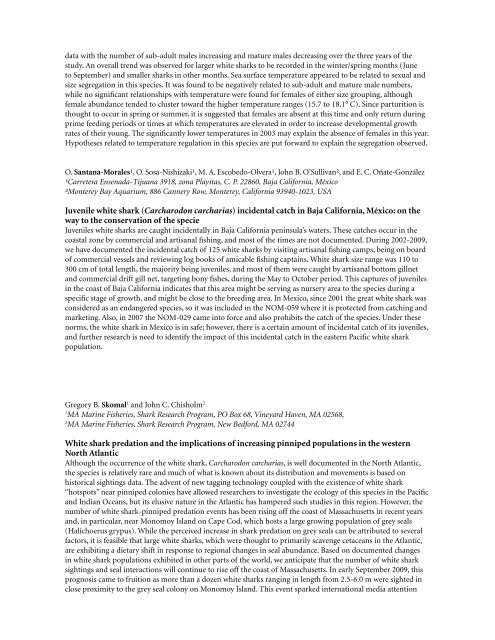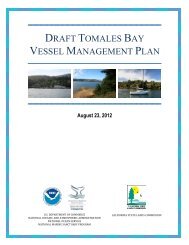Symposium program - Gulf of the Farallones National Marine ...
Symposium program - Gulf of the Farallones National Marine ...
Symposium program - Gulf of the Farallones National Marine ...
Create successful ePaper yourself
Turn your PDF publications into a flip-book with our unique Google optimized e-Paper software.
data with <strong>the</strong> number <strong>of</strong> sub-adult males increasing and mature males decreasing over <strong>the</strong> three years <strong>of</strong> <strong>the</strong><br />
study. An overall trend was observed for larger white sharks to be recorded in <strong>the</strong> winter/spring months (June<br />
to September) and smaller sharks in o<strong>the</strong>r months. Sea surface temperature appeared to be related to sexual and<br />
size segregation in this species. It was found to be negatively related to sub-adult and mature male numbers,<br />
while no significant relationships with temperature were found for females <strong>of</strong> ei<strong>the</strong>r size grouping, although<br />
female abundance tended to cluster toward <strong>the</strong> higher temperature ranges (15.7 to 18.1° C). Since parturition is<br />
thought to occur in spring or summer, it is suggested that females are absent at this time and only return during<br />
prime feeding periods or times at which temperatures are elevated in order to increase developmental growth<br />
rates <strong>of</strong> <strong>the</strong>ir young. The significantly lower temperatures in 2003 may explain <strong>the</strong> absence <strong>of</strong> females in this year.<br />
Hypo<strong>the</strong>ses related to temperature regulation in this species are put forward to explain <strong>the</strong> segregation observed.<br />
O. Santana-Morales¹, O. Sosa-Nishizaki¹, M. A. Escobedo-Olvera¹, John B. O’Sullivan², and E. C. Oñate-González<br />
¹Carretera Ensenada-Tijuana 3918, zona Playitas, C. P. 22860, Baja California, México<br />
²Monterey Bay Aquarium, 886 Cannery Row, Monterey, California 93940-1023, USA<br />
Juvenile white shark (Carcharodon carcharias) incidental catch in Baja California, México: on <strong>the</strong><br />
way to <strong>the</strong> conservation <strong>of</strong> <strong>the</strong> specie<br />
Juveniles white sharks are caught incidentally in Baja California peninsula’s waters. These catches occur in <strong>the</strong><br />
coastal zone by commercial and artisanal fishing, and most <strong>of</strong> <strong>the</strong> times are not documented. During 2002-2009,<br />
we have documented <strong>the</strong> incidental catch <strong>of</strong> 125 white sharks by visiting artisanal fishing camps, being on board<br />
<strong>of</strong> commercial vessels and reviewing log books <strong>of</strong> amicable fishing captains. White shark size range was 110 to<br />
300 cm <strong>of</strong> total length, <strong>the</strong> majority being juveniles, and most <strong>of</strong> <strong>the</strong>m were caught by artisanal bottom gillnet<br />
and commercial drift gill net, targeting bony fishes, during <strong>the</strong> May to October period. This captures <strong>of</strong> juveniles<br />
in <strong>the</strong> coast <strong>of</strong> Baja California indicates that this area might be serving as nursery area to <strong>the</strong> species during a<br />
specific stage <strong>of</strong> growth, and might be close to <strong>the</strong> breeding area. In Mexico, since 2001 <strong>the</strong> great white shark was<br />
considered as an endangered species, so it was included in <strong>the</strong> NOM-059 where it is protected from catching and<br />
marketing. Also, in 2007 <strong>the</strong> NOM-029 came into force and also prohibits <strong>the</strong> catch <strong>of</strong> <strong>the</strong> species. Under <strong>the</strong>se<br />
norms, <strong>the</strong> white shark in Mexico is in safe; however, <strong>the</strong>re is a certain amount <strong>of</strong> incidental catch <strong>of</strong> its juveniles,<br />
and fur<strong>the</strong>r research is need to identify <strong>the</strong> impact <strong>of</strong> this incidental catch in <strong>the</strong> eastern Pacific white shark<br />
population.<br />
Gregory B. Skomal 1 and John C. Chisholm 2<br />
1<br />
MA <strong>Marine</strong> Fisheries, Shark Research Program, PO Box 68, Vineyard Haven, MA 02568,<br />
2<br />
MA <strong>Marine</strong> Fisheries, Shark Research Program, New Bedford, MA 02744<br />
White shark predation and <strong>the</strong> implications <strong>of</strong> increasing pinniped populations in <strong>the</strong> western<br />
North Atlantic<br />
Although <strong>the</strong> occurrence <strong>of</strong> <strong>the</strong> white shark, Carcharodon carcharias, is well documented in <strong>the</strong> North Atlantic,<br />
<strong>the</strong> species is relatively rare and much <strong>of</strong> what is known about its distribution and movements is based on<br />
historical sightings data. The advent <strong>of</strong> new tagging technology coupled with <strong>the</strong> existence <strong>of</strong> white shark<br />
“hotspots” near pinniped colonies have allowed researchers to investigate <strong>the</strong> ecology <strong>of</strong> this species in <strong>the</strong> Pacific<br />
and Indian Oceans, but its elusive nature in <strong>the</strong> Atlantic has hampered such studies in this region. However, <strong>the</strong><br />
number <strong>of</strong> white shark-pinniped predation events has been rising <strong>of</strong>f <strong>the</strong> coast <strong>of</strong> Massachusetts in recent years<br />
and, in particular, near Monomoy Island on Cape Cod, which hosts a large growing population <strong>of</strong> grey seals<br />
(Halichoerus grypus). While <strong>the</strong> perceived increase in shark predation on grey seals can be attributed to several<br />
factors, it is feasible that large white sharks, which were thought to primarily scavenge cetaceans in <strong>the</strong> Atlantic,<br />
are exhibiting a dietary shift in response to regional changes in seal abundance. Based on documented changes<br />
in white shark populations exhibited in o<strong>the</strong>r parts <strong>of</strong> <strong>the</strong> world, we anticipate that <strong>the</strong> number <strong>of</strong> white shark<br />
sightings and seal interactions will continue to rise <strong>of</strong>f <strong>the</strong> coast <strong>of</strong> Massachusetts. In early September 2009, this<br />
prognosis came to fruition as more than a dozen white sharks ranging in length from 2.5-6.0 m were sighted in<br />
close proximity to <strong>the</strong> grey seal colony on Monomoy Island. This event sparked international media attention







